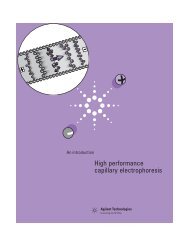Agilent 1290 Infinity LC System - T.E.A.M.
Agilent 1290 Infinity LC System - T.E.A.M.
Agilent 1290 Infinity LC System - T.E.A.M.
- No tags were found...
You also want an ePaper? Increase the reach of your titles
YUMPU automatically turns print PDFs into web optimized ePapers that Google loves.
Type Specifications CommentsSafety and maintenanceExtensive diagnostics, errordetection and display (throughcontrol module and <strong>Agilent</strong> LabAdvisor), leak detection, safeleak handling, leak output signalfor shutdown of pumping system.Low voltages in majormaintenance areas.GLP featuresEarly maintenance feedback (EMF)for continuous tracking ofinstrument usage in terms oflamp burn time with usersettablelimits and feedbackmessages. Electronic recordsof maintenance and errors.Verification of wavelengthaccuracy with built-in holmiumoxide filter.HousingAll materials recyclable.**Details:Note:Specification conditions and calculation (noise, drift) according to ASTM:“Standard Practice for Variable Wavelength Photometric Detectors Used in LiquidChromatography”.Conditions:Cell: Max-Light Cartridge Cell (10 mm, V(s) 1.0 µL) or Max-Light Cartridge Test Cell,Settings: Wavelength 230 nm (or other if advised) with Bandwidth 4 nm and Slit Width4 nm with Reference Wavelength 360 nm / 100 nm; Flow: 0.5 mL/min <strong>LC</strong>-grade water.Time constant 2 secLinearity:Linearity is measured with caffeine at 265 nm with slit width 4 nm and RT 2 s.The specifications are based on the standard RFID tag lamp (5190-0917) and may benot achieved when other lamp types or aged lamps are used.ASTM drift tests require a temperature change below 2 °C/hour (3.6 F/hour) over onehour period. Our published drift specification is based on these conditions. Largerambient temperature changes will result in larger drift. Better drift performancedepends on better control of the temperature fluctuations. To realize the highestperformance, minimize the frequency and the amplitude of the temperature changesto below 1 °C/hour (1.8 F/hour). Turbulences around one minute or less can be ignored.Performance tests should be done with a completely warmed up optical unit (> twohours). ASTM measurements require that the detector should be turned on at least24 h before start of testing.
















